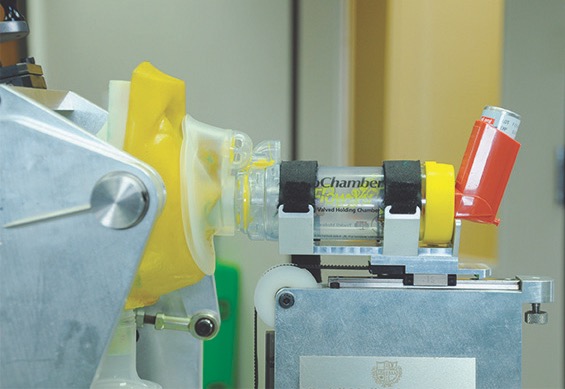Global Aerosol Lab And Research Center
The industry leading aerosol laboratory at Monaghan Medical’s affiliate, Trudell Medical International, uses a variety of recognized standardized procedures and innovative techniques for evaluation of our products. Our staff works actively in the scientific community to:
- Develop in vitro test methodology and standards
- Publish and present papers at scientific meetings and in peer-reviewed journals
- Improve the understanding of aerosol science associated with inhalation therapy
Design verification in our aerosol laboratory shortens time to market and provides a reliable indication of how the device is likely to perform in a clinical setting. We utilize a variety of techniques and the following provides an overview of the function and environment in which the laboratory operates.

- Aerodynamic particle size is routinely measured using cascade impactors according to compendial practices of the US and European Pharmacopeias;
- For products primarily intended for adult use, an Andersen Eight-Stage Impactor or Next Generation Pharmaceutical Impactor (NGI) are used;
- Products intended for pediatric use are tested with a purpose-built low-flow Marple-Miller Impactor;
- Assessment of aqueous aerosols from nebulizers measured in accordance with CEN standard EN 13544-1:2007 as well as other recognized global standards;
- We routinely validate our measurements by mass balance assessments;
- We measure particle size using laser diffractometry, a useful technique for liquid droplets from our nebulizer systems;
- We employ different types of breathing simulators to test the performance of our products under conditions that simulate actual patient use. This has helped us:
- Develop a device that simulates delayed inhalation to simulate poor timing between operation of drug delivery device and inhalation maneuver;
- Mimic in vivo drug delivery to patients with low inspiratory flow rates (e.g. infants);
- Test drug delivery rates over several respiratory cycles (especially useful when testing nebulizers);
- Develop infant, small child and adult face models (ADAM – Aerosol Delivery to Anatomical Model) with realistic surface texture to test facemask fit and aerosol delivery with facemask intact for products intended for use by infants, small children and adults.
- Through our commitment to aerosol-based drug delivery standards we are continuously developing better ways of performing in vitro measurements on our products and support the development of improved testing methodologies;
- We participate in the development of international standards by working with committees such as the ISO/TC84/JWG5 committee from the International Standards Organization;
We participate in industry-wide technical expert bodies, such as the European Pharmaceutical Aerosol Group (EPAG) and in the activities of the US-based Product Quality Research Institute (PQRI) to help develop better guidelines for regulatory testing.

